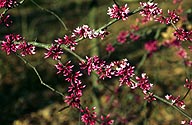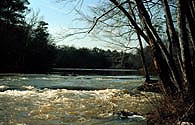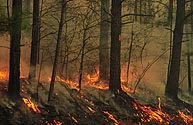|
Overview
We are a team of scientists, teachers, students,
land managers, business people and
concerned citizens centered around the Oconee National Forest.
Our mission is to promote local education, science and conservation.
We want more discovery, creative thinking,
and hands-on practical experience in our children's curricula.
We want to unlock the mysteries of living things and ecosystems around us.
We want to conserve, use and enjoy our outdoors more wisely.
Please help us to provide the leadership, support,
training and technology needed to create new programs and achieve these goals.
Together we can share life's wonders and
the thrill of discovery with our children.
We can empower them to learn valuable scientific
and technical skills while studying nature.
We can to contribute to the knowledge needed
to better manage and protect our environment's health.
|
Customized identification guides
Checklists with images, maps, and links
Albums of site participants
under development
Oconee National Forest
-
Location
The Oconee National Forest is in Georgia, approximately 20 miles southeast of Athens and, similarly, north of Macon.
Nearby counties include Baldwin, Bibb, Butts, Clarke, Greene, Jasper, Jones, Monroe, Morgan, Oconee, Oglethorpe, and Putnam;
neighboring communities, Eatonton, Greensboro, Madison, Milledgeville, Monticello, and Watkinsville.
-
Management
The Oconee Ranger District of the USDA Forest Service manages the forest. The district headquarters is new. It is
approximately 5 miles north of Eatonton on the west side of US highway 129/441, just south of Rock Eagle.
Barnie Gyant is the District Ranger. His staff of 17 includes a wildlife biologist, Liz Caldwell.
-
Size & fragmentation
The Oconee Ranger District currently includes approximately 118,000 acres.
These acres are in a highly-fragmented mosaic of public and private land.
The district is divided into several large areas seperated from each other.
Within these areas, many roads and private in-holdings further fragment the forest.
-
History & disturbance
The forest's history is one of disturbance.
Native Americans used fire to manage the area for game. Europeans then cleared most of the trees and plowed the land,
primarily to cultivate cotton. With the boll weevil and Great Depression, farmers largely abandonded row crops.
Land was then used for grazing cattle and then extensive timber production. Until recently, the forest
produced an average of over 20 million board feet of sawlogs per year. A fraction of one percent of the land is old-growth forest
that was never cleared. Because of farming and erosion, little of the area's original top-soil remains.
ological richness
Despite its distrubance, the Oconee National Forest may be one of the richest areas of biological diversity in the temperate world.
An unknown but high proportion of species in southern and eastern North America most likely occur in this piedmont area, in part because
it is between the species-rich Appalachian Mountains and the coastal plain. Its rolling hills contain a variety
of upland, slope, bottomland and aquatic habitats. Its terrestial landscape is a patchwork of open and early successional stages
distributed throughout a diverse array of pine-hardwood stands that vary in their species composition, density and maturity.
The Apalachee, Ocmulgee, Oconee and Little rivers, Murder Creek, Lake Oconee and Sinclair, and a multitude of smaller creeks, beaver
ponds, and wetlands provide a diversity of aquatic habitats. Its endangered species include bald eagles and red-cockaded woodpeckers.
-
Restoration & recreation
Since establishing the forest in 1959, the Forest Service has managed it for timber, water, minerals, range, wildlife and recreation.
They are now revising a new management plan that may shift the emphasis from one of extraction to one of restoration and
recreation. Because of the forest's location and large size, its sound management is fundamental
to conserving the Piedmont's rich biological diversity and protecting its endangered species from encroaching development.
Furthermore, as the forest is restored to its former health and beauty, it will become ever more popular
by providing better hunting, fishing, hiking, camping, picnicing, riding and other outdoor opportunities
to Georgia's growing population.
-
Long-range vision
Trees take a long time to grow. Forest communities take even longer to restore.
Forest planning has been done with too short a vision. We must ask long-range questions.
What do we want the forest to be in 100 years? In 500 years? How many mature pine
and hardwood stands are needed to conserve healthy populations
of all the region's species? What is the optimal mix of open and forested lands
to protect the ecosystem's health and to satisfy the hunters and hikers from
next century's Greater Atlanta-Macon metropolis?
More information
Prior events
-
Wednesday, 2 May, 2001 -- Benefit Concert -- Georgia Theatre, Lumpkin St., Athens
Caroline Aiken, Atlanta singer/songwriter
Breathlanes, Athens' group, featuring guitarist John Miley and vocalist Elissa Hadley.
Drivin' 'N Cryin' with guitarist Kevn Kinney, Kyle Pilgrim, John Keane & others.
Calliope Fair, Athens' group, featuring George Norman on mandolin and Andres Curty on violin.
Great success -- Thank you everyone!!!
-
16 April, 2001 -- Discoverlife Day -- Oconee National Forest
The students in Ms. Guerrero's AP Biology class at Cedar Shoals High School will start an experiment in the Oconee National Forest.
They will take photographs and collect data to document species in hardwood stands, some of which will be burned next winter.
Forest Service personnel, University of Georgia faculty, including Dr. Eugene Odum, professional photographers,
and other volunteers will help teach and with logistics.
Georgia Outdoors (Public Television, Channel 8) will film the students learning how to use cameras, identify species, and record data.
-
17 April, 2001 -- Presentation & Organizational Meeting -- Athens-Clarke County Library
"Biodiversity and the Oconee National Forest" -- slide presentation by John Pickering, University of Georgia.
Organizational meeting -- community input and discussion of how we should proceed.
Contacts
-
Nancy Lowe, Outreach Coordinator, Discover Life -- nancy@discoverlife.org -- 404-272-4526
| |
Updated: 11 July, 2011
| |
Discover Life
| Projects
| Study sites
| Top
| |
© Designed by The Polistes Corporation
|
|







